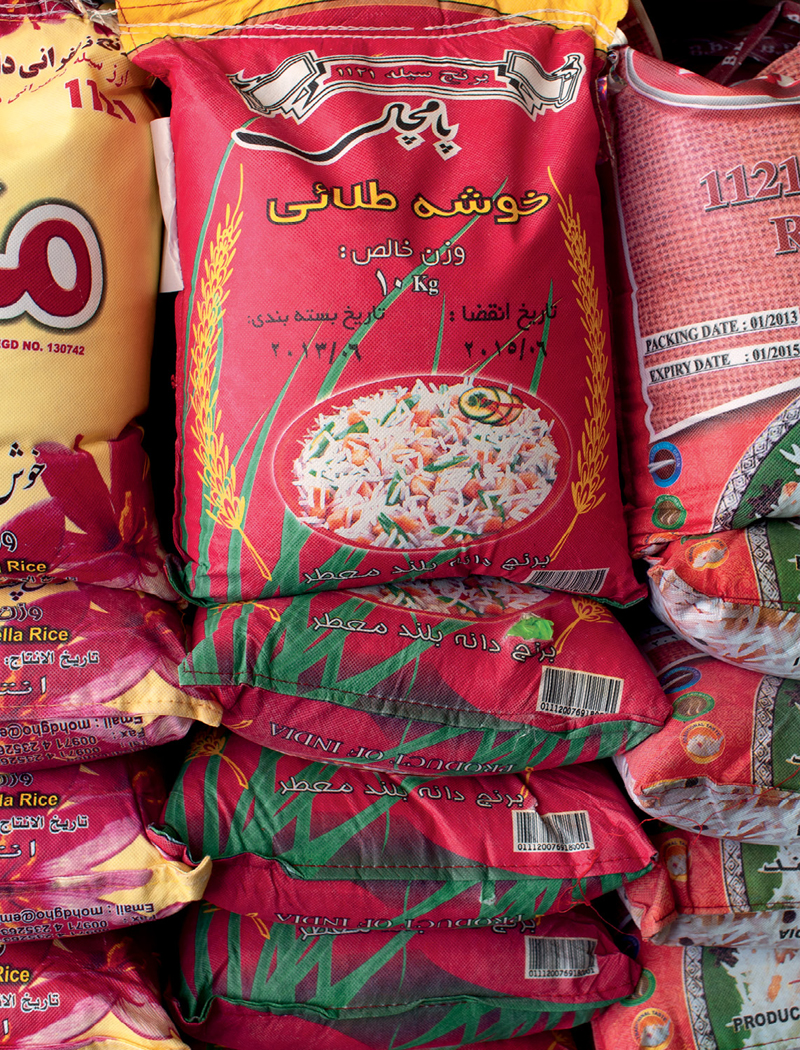

Yazd, Iran—Bags of long-grain basmati-style rice for sale, all of them marked “Product of India.”
Rice is an honored and beloved staple in the Persian culinary world, from Iran to Azerbaijan and Kurdistan, and Persian rice cookery is in a class of its own. In Iran, rice grows near the Caspian Sea in Gilan Province and near Shiraz. The Persian rices used in savory dishes are long-grain and resemble basmati but, Iranians will tell you, are better than basmati; basmati is the closest equivalent available in North America.
Basic Persian Rice (chelo) is the model for the other flavored Persian rice dishes in this chapter. The rice is soaked, then briefly boiled and, finally, steamed. The bottom crust, tahdig in Persian, is a special treat, put out with the rice. In Azeri plov (a word related to polo, pulao, perloo, and paella), the rice is usually cooked using a method very similar to that for Persian chelo.
Among the Kurds of Kurdistan, rice is daily fare, eaten with bread and simply flavored (see Kurdish Black Rice, Red Rice, and Golden Rice). Kurdish rice, birinji kurdi, is completely unlike Persian rice, as it’s short- to medium-grain, like Mediterranean rices; the cooked rice dishes resemble risotto but include a delicious bottom crust. Rice is grown in Iraqi Kurdistan but not exported; Arborio or Baldo is the best substitute.
Rice is more important among western Armenians than for people from eastern Armenia, for whom wheat is the staple. Armenian cooks work with wheat in many ways: to make soups and pilafs (see Emmer Mushroom Pilaf) as well as the festive traditional dish herissah (see recipe), where it’s blended with lamb or chicken in a hearty kind of main-dish porridge.
In Georgia both wheat and corn rule. The smooth-as-silk Georgian dish called ghomi (see recipe), made of white cornmeal, is like a sleek version of polenta, and a favorite in my house.
This rice sets the standard for rice cookery from Azerbaijan to northern India. It is tender and moist, every grain separate and perfect, with a crust at the bottom of the pot that is crisp and flavorful. The Persian word for that crust is tahdig.
This recipe is the master recipe for the Persian rice dishes that follow. They all use the same method for cooking the rice; the variations come with the different ingredients used to flavor it. The constants are rice and time: You need to start soaking the rice at least 2 hours before you serve it.
Use high-quality rice: Persian long-grain rice or basmati rice, both of which can absorb a lot of water. The rice is washed and then soaked in salted water for at least an hour. The soaking gives the rice a chance to absorb water, which in turn contributes to even cooking.
After the soaking comes parboiling: The rice is sprinkled into a large pot of boiling salted water, as if it were pasta. This step requires attention, for the rice can take as little as 5 minutes or as long as 10 to 12, depending on its age and quality. The rice should be cooked just until it is no longer raw but not fully cooked; the centers of the grains are no longer hard and chalky, but the rice is still chewy, not tender.
The last step is steaming: A heavy pot is lined with a layer of rice mixed with yogurt and perhaps egg, or with flatbread or potato (see A Note on Crust), and the (remaining) rice is mounded on top in a conical shape. The lid is sealed tightly and the rice steams gently for 30 minutes over low heat. The process may seem complicated the first time you try it, but you’ll understand the reason for each step once you taste the results. And once you’ve made it a few times, cooking perfect Persian-style rice will become an easy habit.
Serves 8
3 cups (1¼ pounds) Persian or basmati rice
Sea salt
2 to 3 tablespoons plain yogurt, preferably full-fat
1 medium or large egg
¼ cup sunflower oil or butter-ghee
About 2 tablespoons butter, cut into small chunks
2 to 3 tablespoons Saffron Water (see recipe; optional)
Wash the rice: Place it in a pot, pour on cold water generously, and swish it around, then drain in a sieve; repeat three more times, or until the water remains clear. Place the rice in a bowl, add water to cover by 2 inches, and stir in 2 tablespoons salt. Set aside to soak for at least 1 hour; drain.
Fill a large heavy pot with about 4 quarts water and bring to a boil. Add 1 tablespoon salt, bring back to a boil, and sprinkle in the rice. Stir gently and bring back to a boil. After 2 to 3 minutes, start testing the rice for doneness: It is ready when the center of the grains is no longer brittle but is still chewy, not fully cooked. Check the rice frequently and once it’s done, usually 4 to 5 minutes after it comes back to a boil (but it can take longer), drain in a sieve and set aside for a moment.
Mix the yogurt and egg together in a medium bowl. Stir in about 1 cup of the parboiled rice. Place the pot back over medium-high heat, add the oil or ghee and 2 tablespoons water, and heat until hot. Sprinkle the yogurt-rice mixture onto the sizzling oil and water, and mound the remaining rice on top in a conical shape. Use the handle of a wooden spoon to make four or five holes in the rice and sprinkle the chunks of butter over the rice. Cover the pot with a heavy lid or a lid wrapped in a cloth to help seal it well and steam the rice for about 3 minutes. Reduce the heat (move the pot to another burner if using an electric stove) to very low and cook for 25 minutes or so; the rice should be tender and fluffy. Remove from the heat.
The crust will come up more easily if you place the bottom of the pot in cold water for a couple of minutes (fill the sink with several inches of cold water). Mound the cooked rice on a platter. If using the saffron water, scoop about 1 cup of cooked rice into a bowl, add the saffron water, and stir to mix; set aside and sprinkle the saffron-tinted rice on top. Lift out the crust in pieces and place them around the edges of the steamed rice.
A Note on Crust: Different cooks have definite preferences about tahdig. I prefer a crust made with rice mixed with yogurt and egg. You can use either yogurt or egg rather than both. Other people instead place a layer of thin flatbreads in the oiled pot to make the crust, or perhaps some thinly sliced parboiled potatoes, before mounding the rest of the rice on top. Instructions for all options follow.
Crust Choices: Instead of the egg and yogurt, you can use just yogurt (about ¼ cup) or just egg (1 extra-large or 2 medium), with ¾ cup rice. For a potato crust, use sliced parboiled potatoes or grated potatoes, enough to cover the bottom of the pot, on their own or mixed with a little yogurt or an egg. For a flatbread crust, line the bottom of the pot with a layer of thin bread (a split pita or a thin lavash, for example). (Or see Jairan’s Chicken Plov for another type of flatbread liner.) Place the potatoes or bread on the hot oil and water before mounding the rest of the rice on top.
Use the same method to cook brown basmati, but omit the saffron water. The rice will take 14 to 18 minutes to parboil. Sprinkle on about 3 tablespoons water along with the butter chunks. Steaming will take about 45 minutes. Because the top layer of brown rice is often a little more chewy, sample from a little lower in the pot to test for doneness after the steaming.
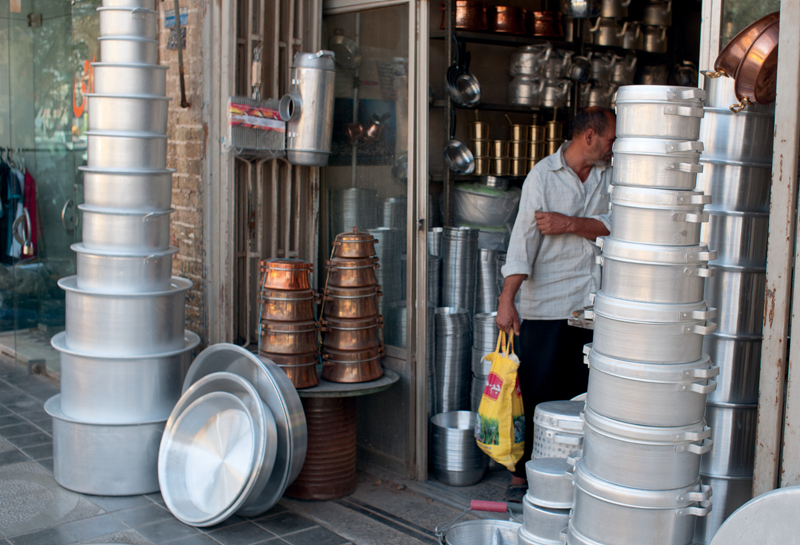
Yazd, Iran—A man carrying a bag of rice he just bought stops at a shop in the bazaar that specializes in pots of all kinds.
Photograph here
Polo sabzi is layered with finely chopped herbs as it steams, which make it aromatic as well as beautiful. (You can substitute dried herbs if fresh are not available; use about 2 tablespoons each of two different herbs and mix them with the parboiled rice before steaming it.) It’s always served at Nou-Roz, the Persian New Year, celebrated at the spring equinox.
Leftovers keep well and can be reheated in a pan with a little hot water to steam them. Or lightly toss in hot oil, with the addition of a few chopped fresh greens to perk things up.
Serves 6 to 8
3 cups (1¼ pounds) basmati rice, washed and drained
Sea salt
2 to 3 tablespoons plain full-fat yogurt
1 medium or large egg
3 cups finely chopped mixed fresh herbs, such as coriander, flat-leaf parsley, dill, and scallions (choose two or more)
1 garlic clove, minced, or ¼ cup minced fresh garlic chives
2 tablespoons sunflower oil or butter-ghee
2 to 3 tablespoons butter, cut into small chunks
2 to 3 tablespoons Saffron Water (see recipe; optional)
Place the rice in a large pot and add water to cover by 2 inches. Stir in 2 tablespoons salt and let the rice soak for an hour or two; drain.
Bring a large pot of water to a boil. Add 1 tablespoon salt and bring back to a vigorous boil. Sprinkle in the soaked rice, stir, and bring back to a boil (add the dried herbs here, if using). Boil the rice until slightly softened but not cooked through, 3 to 5 minutes. Drain in a fine sieve and set aside for a moment.
Mix the yogurt and egg together in a medium bowl. Scoop up about 1 cup rice and mix it into the yogurt-egg mixture; set aside.
Combine all the chopped greens and the garlic or garlic chives in a bowl and mix well.
Place a wide heavy pot over medium-high heat. Add the oil or ghee and 2 tablespoons water and heat until sizzling. Sprinkle on the yogurt-rice mixture, then sprinkle on about 1 cup of the remaining rice and top with about one-third of the chopped greens. Continue alternating layers of rice and greens, mounding the rice in a conical shape, ending with rice. Poke four or five holes in the rice with the handle of a wooden spoon. Sprinkle on the chunks of butter. Cover the pot tightly (wrap the lid in a cotton cloth if necessary) and steam the rice over high heat for another minute. Reduce the heat to very low and cook for 30 minutes or so, until the rice is very tender and fluffy.
Set the pot in a sink filled with 2 inches of cold water and let stand for a couple of minutes. (This will help the bottom crust release.) If using the saffron water, scoop about 1 cup of cooked rice into a bowl, add the saffron water, and stir gently to mix; set aside. Mound the rest of the cooked rice on a large platter and sprinkle on the saffron-tinted rice. Lift out the crust in pieces and place them around the edges of the steamed rice.
Brown rice is not at all traditional for polo, but I do love it. Follow the directions for the herbed rice above but omit the saffron water. The rice takes longer to cook: Allow a generous hour. The rice will take 14 to 18 minutes to parboil. Sprinkle on about 3 tablespoons water along with the butter chunks. Steaming will take about 45 minutes. Because the top layer of brown rice is often a little more chewy, sample some from a little lower in the pot to test for doneness after the steaming.
Photograph here
Tart barberries give flavor and color to Basic Persian Rice (see recipe). Soak 1 cup dried barberries in water for 30 minutes and drain. Follow the directions for the herbed rice above, but instead of layering in chopped herbs, mix the drained barberries in with the parboiled rice before mounding it on top of the crust mixture. Cook and serve as above.
Photograph here
This is one of my all-time favorite ways of cooking rice. With the simple addition of walnuts and pomegranate molasses, the rice is transformed into a richly flavored dish that’s like a lush risotto. Astonishing. Though its name in Kurdish means black rice, the rice is not actually black but just darkened by the flavorings in the cooking water. Serve as part of a vegetarian meal or alongside roast chicken, with a salad.
Serves 6
2 cups (¾ pound) Arborio or Baldo rice
4 cups water
5 tablespoons pomegranate molasses
3 tablespoons sunflower or extra-virgin olive oil
2 or 3 shallots, finely chopped (about 3 tablespoons)
1 tablespoon sea salt
¾ cup walnuts, chopped into small pieces
Wash the rice thoroughly in several changes of cold water; drain in a sieve. Pour 4 cups water into a bowl and stir in the pomegranate molasses. Set aside.
Place a wide heavy pot over medium-high heat. Add the oil, toss in the shallots, and stir. Cook until translucent. Add the pomegranate molasses mixture, raise the heat, and bring to a vigorous boil. Add the salt, then add the walnuts and rice. Bring back to a strong boil, stir, and cook, uncovered, until the water level is just at the top of the rice, about 5 minutes.
Cover the pot, reduce the heat to very low, and cook for 12 to 15 minutes, until the rice is tender. The texture will be like risotto, a thick-flowing mass. Remove from the heat, stir briefly, and set aside, covered, to rest for 10 to 15 minutes.
Serve the rice from the pot. There will be a layer of rice stuck to the bottom of the pot. The pot scrapings are delicious and a sought-after treat.
This is the simplest of the Kurdish home-style rice dishes. The tomato gives it a slightly tart edge, so it’s good with plain grilled meat or with slightly sweet dishes, such as those with beets or sweet potatoes, or with grilled onions.
Include a generous Herb Plate (see recipe) with the meal; the greens are beautiful next to the tinted rice.
Serves 6
2 cups (¾ pound) Arborio or Baldo rice
4 cups water
3 tablespoons tomato paste
3 tablespoons sunflower or extra-virgin olive oil
2 or 3 shallots, finely chopped (about 3 tablespoons)
1 tablespoon sea salt
Wash the rice thoroughly in several changes of cold water; drain in a sieve. Pour 4 cups water into a bowl and stir in the tomato paste. Set aside.
Place a wide heavy pot over medium-high heat. Add the oil, toss in the shallots, and stir. Cook until translucent. Add the tomato mixture, raise the heat, and bring to a vigorous boil. Add the salt, then add the rice. Bring back to a strong boil, stir, and cook, uncovered, until the water level is just at the top of the rice.
Cover the pot, reduce the heat to very low, and cook for 12 to 15 minutes, until the rice is tender. The texture will be like risotto, a thick-flowing mass. Remove from the heat, stir briefly, and set aside, covered, to rest for 10 to 15 minutes.
Serve the rice from the pot.
Golden rice is tinted yellow with turmeric and cooked in chicken broth rather than water. It can include meat, but the versions I tasted in Kurdistan were served with meat alongside the rice rather than in it. It’s rather like risotto, not in terms of the cooking technique, but because the broth gives the rice a risotto-like lushness.
I find it easiest to use the method I learned from home cooks in Kurdistan: I simmer two chicken legs in about 5 cups water with a chopped onion for an hour or so, lift out the chicken, and use that cooking liquid (plus extra water if needed) as the broth for cooking the rice. Serve the rice with chicken, grilled meat, or a hearty bean dish. Accompany with an Herb Plate (see recipe) and a chopped salad or a vegetable dish.
Serves 6
2 cups (¾ pound) Arborio or Baldo rice
3 tablespoons sunflower or olive oil
2 or 3 shallots, finely chopped (about 3 tablespoons)
4 cups unsalted chicken broth, homemade (see headnote) or store-bought
1 small onion, minced, if using store-bought broth
1 teaspoon turmeric
½ teaspoon ground cumin
½ teaspoon ground coriander
1 tablespoon sea salt (or about 1 teaspoon if using salted broth)
Wash the rice thoroughly in several changes of cold water; drain in a sieve.
Place a wide heavy pot over medium heat. Add the oil, toss in the shallots, and cook, stirring occasionally, until translucent, a couple of minutes. Add the broth, raise the heat, and bring to a vigorous boil. If using store-bought broth, add the minced onion. Add the spices and salt, bring back to a strong boil, and add the rice. Bring back to a strong boil, stir, and cook, uncovered, until the water level is just at the top of the rice.
Cover, reduce the heat to very low, and cook for 10 to 15 minutes, until the rice is tender and plump. Remove from the heat and stir gently. Cover and let stand for 10 to 15 minutes before serving.

Sulaymaniyah, Kurdistan—This well-stocked rice shop in the Sulaymaniyah bazaar sells rice from many places, including India, the United States, and Uruguay, as well as many kinds of tea.

North of Kerman, Iran—The view from the train windows on our overnight journey to Mashad. Much of the way the countryside is bare and dry due to the drought Iran has had since 2008.
On the overnight train from Kerman in southern Iran to Mashad, in the north, I was lucky to meet an English-speaking young woman named Fereshteh as we both sipped an early-morning tea in the dining car. My time with the five women in my compartment (see Train Journey), none of whom spoke much English, had left me with many questions she was happy to answer.
I asked her whether her mother ever spoke about the impact of the Islamic Revolution on women of her generation, especially educated women in the cities. Overnight, they had gone from relative autonomy, with the freedom to go to parties and go out by themselves, dressed as they wished, to being subject to rules about clothing and decorum, in a sense persecuted for being women. My understanding of the period came from other conversations and from Azar Nafisi’s Reading Lolita in Tehran. Fereshteh said her mother didn’t talk about it. Was it too painful?
I asked if she, Fereshteh, ever chafed under the restrictions: having to cover herself with a head scarf and manteau, for example. Well, she said, things have improved. “Now I can work at the university and I can travel on my own on this overnight train to see my husband [whose job was in Mashad]. Things are still evolving,” she went on. “In Iran, we now mistrust revolutions. We realize that evolution is better than revolution.” I didn’t want the conversation to end, but eventually the outskirts of bustling Mashad came into view, and it was time to make my way back to my compartment through the crowded narrow aisles of the train cars. Families were gathering themselves, groups of men leaned against the windows looking out, women adjusted their chadors and head scarves, and slowly we lurched to a halt in the station.
This version of Persian rice is stunning, a meal-in-one of aromatic chicken (or lamb; see the variation) encased in a flavorful crust of basmati rice. It’s a golden “cake” that is turned out onto a plate and served warm or at room temperature, sliced into wedges. Tahchin makes great finger food for a picnic or a casual gathering. Serve with salad and a side dish such as Eggplant Borani (see recipe).
The chicken is marinated in yogurt flavored with dried orange peel and then buried in the rice to cook. The festive version of the dish is lush with butter, but for a home-cooked meal on a weeknight, you may want to use a little less butter.
Serves 8
3 tablespoons sunflower oil or butter
½ cup minced onion
About 1½ pounds boneless chicken legs or breasts, or a combination, cut into bite-size pieces
3 tablespoons fresh lemon juice
1 teaspoon sea salt
2 teaspoons dried orange peel (see Glossary)
½ cup plain full-fat yogurt
1 large egg
3 cups (1¼ pounds) basmati rice
Sea salt
5 to 8 tablespoons melted butter (see headnote)
Up to 24 hours before you want to serve the dish, make the filling: Place a heavy skillet over medium heat and add the oil or butter. Toss in the onion and cook for a minute or two, until translucent. Add the chicken and cook, stirring occasionally, for 10 minutes. Add the lemon juice and salt, half cover, and cook over medium-low heat for 10 minutes. Remove from the heat and let cool to room temperature.
Meanwhile, place the orange peel in a small saucepan, add 2 cups water, bring to a boil, and boil for 2 to 3 minutes. Drain. Place the peel back in the saucepan, add 2 cups water, and bring to a boil. Remove from the heat and set aside to soak for 5 to 10 minutes, until the peel is well softened.
Drain the orange peel and mince it. Place the yogurt in a medium bowl and mix in the peel. Add the chicken, cover, and marinate in the refrigerator for at least 3 hours, and up to 24 hours.
At least 3 hours before you want to serve the dish, wash the rice well in several changes of water and place in a bowl with water to cover by 2 inches. Add 2 tablespoons salt, stir well, and set aside to soak for 1 to 2 hours.
Preheat the oven to 375°F. Use some of the melted butter to generously oil a deep 12-inch casserole or other heavy ovenproof pot with a lid.
Using a slotted spoon, lift the chicken out of the marinade and set aside on a plate. Add the egg to the marinade, whisk to mix well, and set aside.
Drain the rice. Bring a large pot of water to a rolling boil. Add 1 tablespoon salt, bring back to a boil, and add the rice. Cook until the rice is no longer brittle but is still chewy, not fully cooked. Check the rice frequently, and once it’s done, usually about 5 minutes after it comes back to a boil, drain it in a fine sieve.
Add 3 cups of the rice to the egg-marinade mixture and mix well. Transfer the mixture to the buttered casserole, spreading it over the bottom and 1½ to 2 inches up the sides of the pot. Distribute the chicken pieces over the rice, leaving a 1-inch border all around. Spread the rest of the rice over the chicken, covering it completely, and smooth the top. Drizzle on 3 tablespoons or more of the melted butter.
Cover the pot with a heavy lid and bake for 45 minutes. Lower the heat to 350°F and bake for another 45 minutes. The top of the rice should be golden brown.
Fill your sink with 2 inches of cold water and place the casserole in the water for 5 minutes; this will help the rice crust release from the pot.
Remove the pot from the water and slide a knife around the sides of the pot to help release the rice. Place a large plate or platter over the casserole and invert it, so that the tahchin falls onto the plate. Serve hot or at room temperature.
Substitute 1½ pounds boneless lamb shoulder or leg, cut into bite-size pieces, for the chicken. Cook with the onion, as above, but after the lamb has cooked for 10 minutes, add ½ cup barberries (see Glossary) and ¼ cup water, or ¼ cup pomegranate molasses diluted with ¼ cup water to the pan, then cook for 15 minutes at a low simmer. Let cool and proceed as above, but omit the orange peel.
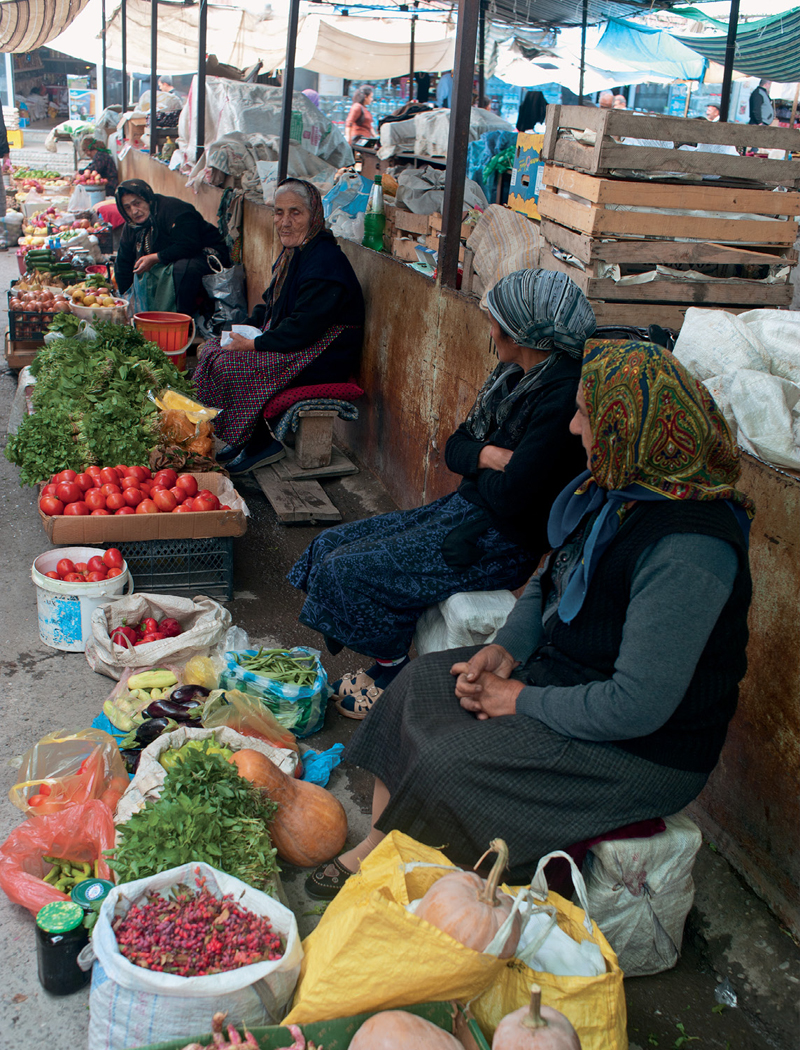
Sheki, Azerbaijan—Vendors in the main market in Sheki sit in long lines next to their vegetables and herbs, which gleam with freshness. The woman in the foreground has a bag of barberries; several jars of preserves; a large bunch of basil; bags of tomatoes, peppers, and eggplants; and a large squash.
Plovs have “special dish” status in Azerbaijan. The rice requires a little care and so does the simmered chicken, but it’s well worth it. This is a great dish to make for a crowd or for a celebration. I learned it from Jairan in Lahich.
Start by putting the rice on to soak about 4 hours before you want to serve. Once you have your prep done, cooking the rice and assembling the dish takes about an hour. The crust is different from the crusts in the other rice dishes in this chapter—it’s made of a dough that bakes under the rice.
In this dish, the most important detail is the way the onions are sliced and cooked. They are sliced very thinly lengthwise, as opposed to the usual crosswise slices. Cut this way, they melt into the chicken.
A classic side for plov and other rice-and-meat dishes is Tart-Sweet Apricot and Raisin Relish (see recipe). Put out a plate of trimmed scallions and sprigs of fresh herbs, such as coriander, basil, and mint; you could also or instead include watercress or arugula. Serve a salad of chopped tomato and cucumber, such as Baku-Style Tomato Salad (see recipe), or put out a bowl of lightly salted thick yogurt.
Serves 8
4 cups (generous 1½ pounds) basmati rice
Sea salt
2 tablespoons sunflower or vegetable oil
¼ teaspoon saffron threads, soaked in ¼ cup hot water
About 3 pounds chicken legs or breasts, or a combination
About 4 cups water
8 medium or 5 large onions
12 dried sour plums, or substitute 12 small or 8 large tomatillos
About ¼ cup (4 tablespoons) sunflower oil, butter, or butter-ghee
2 teaspoons turmeric
2 teaspoons sea salt, or to taste
1 large egg
Scant ½ cup plain full-fat or reduced-fat yogurt
1 teaspoon sea salt
About 2½ cups all-purpose flour
Place the rice in a wide bowl and add water to cover by 2 inches. Set aside to soak for 2 hours.
Using a cleaver, chop each chicken leg and/or breast into several pieces. Pull off the skin and discard. Put the chicken pieces in a wide heavy pot, add 2 inches of water, and bring to a boil over medium heat. Reduce the heat and simmer, partially covered, for about 30 minutes. Set aside.
Meanwhile, remove the tough outer layers of the onions. Cut them lengthwise in half and then slice them lengthwise into very thin slices, almost like shreds. (You should have about 6 cups sliced onions.) Set aside.
If using sour plums, place them in a bowl, rinse, and drain. Cover with water and set aside to soak for 10 to 20 minutes. If using tomatillos, remove their papery husks, rinse, and cut in half or into quarters; set aside.
Place a wide heavy skillet over medium heat and add the onions without any oil. Cook, stirring occasionally, for 5 to 10 minutes; lower the heat a little if necessary to prevent the onions from sticking or changing color—you just want them to release some of their moisture. Add the oil, butter, or ghee, sprinkle on the turmeric, and stir the onions to coat them with oil or butter. Partially cover and cook over medium to medium-low heat, stirring occasionally, for 10 to 15 minutes. You don’t want the onions to change color, just to gradually soften.
Add the drained sour plums or the tomatillos and cook, partially covered, for 10 minutes, lowering the heat if necessary to prevent the onions from burning and using a wooden spatula to scrape the bottom of the pan and keep them from sticking. Remove from the heat and set aside in a bowl.
Pour the cooking liquid from the chicken into a bowl. Arrange the chicken pieces evenly in the pot and strew the onions and plums or tomatillos over the top. Add the chicken cooking liquid and the salt, and bring to a boil over medium-high heat. Reduce the heat to medium-low, partially cover, and simmer for 30 minutes. Set aside (refrigerate, covered, if the wait will be longer than an hour).
Meanwhile, make the crust: Mix the egg, yogurt, and salt in a bowl. Add about a cup of the flour and stir, then add more flour, folding and kneading it in, until you have a soft, smooth dough. Lightly dust the dough with flour, place it on a lightly floured surface, and flatten it into a disk. Then continue to flatten with your palm, or use a rolling pin, until you have a round that has the same diameter as the pot you will use to cook the rice. Cover loosely.
An hour before you want to serve the dish, fill a large heavy pot with hot water and bring to a boil. Add about ¼ cup salt and bring back to a boil. Drain the rice and rinse well with cold water. Add the rice to the boiling water and bring back to a boil, stirring gently to ensure that no rice sticks to the bottom of the pot. It will take from 5 to 10 minutes for the rice to cook to almost done. Test by lifting out several rice grains and biting them; they should be almost cooked through, with no starchy chalkiness. Drain the rice in a large sieve.
Rinse out the pot and place it over medium-high heat. Add the 2 tablespoons oil and take the pot off the heat. Fold in a flap of dough on all four sides of the circle of dough, place the dough in the center of the pot, and unfold the flaps so that the bottom of the pot is covered with dough. Use a small thin glass to cut as many rounds as possible in the dough. Place the pot back over medium-high heat.
Add half of the rice to the pot, mounding it, and pour over half the saffron liquid. Add the remaining rice, mounding it into a conical shape, and pour on the rest of the saffron liquid. Poke four or five holes in the rice with the handle of a wooden spoon.
Cover the pot tightly (wrap the lid of the pot in a cotton cloth if necessary). Reduce the heat to very low and cook for about 45 minutes, until the rice is tender and fluffy. Set aside to rest for 10 minutes, until ready to serve.
Just before serving, gently reheat the chicken mixture. Taste and adjust the seasoning if necessary.
Mound the rice onto a platter and place the rounds of dough around the edge of the platter (the dough scraps are usually discarded). Serve the chicken in a separate bowl, or ladle it onto the platter of rice and serve the extra gravy in a separate bowl.
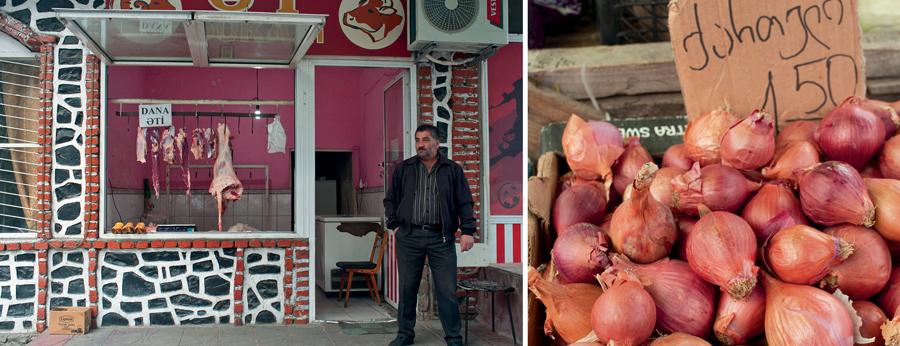
Left: Sheki, Azerbaijan—A butcher stands outside his small shop not far from the main bazaar.
Right: Tbilisi, Georgia—Shallots for sale in Deserteri Market.
Wheat is the food of life in Armenia, as it is in the rest of the region. Over the centuries, Armenians have discovered many ways to work with it, apart from using wheat flour to make bread.
An early type of wheat, known in English as emmer, is an important ingredient there. Emmer (see Glossary) is now widely available in North America. The Armenian name is hajar. It cooks much more quickly than modern wheats and so it can be used in soups without presoaking (see Dried Apricot Soup with Wheat Berries), or to make risotto-like dishes called pilav (see Emmer Mushroom Pilaf).
In Armenia, soft wheat berries are used to make tsavar—precooked dried wheat berries. Until recently, it was made in the villages, but now people buy ready-made tsavar at the market. The traditional village processing involved washing the grain, cooking it in water, and then leaving it out in the sun to dry so it could be stored safely.
Tsavar is used in a number of ways. Whole tsavar is cooked with meat and then mashed to make herissah, often called the Armenian national dish, which is a kind of meat porridge (see recipe). Herissah can also be made with soft wheat berries that have not been transformed into tsavar, but the cooking time is longer. Bulgur (gorgot) is also made from tsavar: the dried wheat berries are pounded into flakes, which makes the grain even quicker to cook. Coarse bulgur (hushor) is used for pilafs and dolmas (see Cabbage Rolls Stuffed with Beans and Tart Fruit), and finer bulgur (gorgudak) is used for tabbouleh, especially in western Armenia. Tsavar is also the basis of po-khinze, a precooked flour made by toasting the cooked dried wheat berries and grinding them.
Po-khinze is a practical ingredient, for it needs very little additional cooking (very like Tibetan tsampa, which is the barley equivalent). In Armenia, po-khinze is combined with water to make a gruel or porridge called khasheel, among other dishes. The porridge is sweetened with honey, sugar, or some kind of preserved fruit or sweet fruit syrup and enriched with butter and yogurt, and sometimes walnuts.
Wheat is also part of many ritual dishes at certain holidays. A few weeks before Easter, for example, which is the time of resurrection for Christian Armenians and also the season of the Zoroastrian New Year in the Persian world (see here), Armenian families, like Georgian families, sprout wheat berries. A plate of the sprouted wheat, vibrantly green, is used as a centerpiece on the Easter feast table, usually with eggs on top, signifying resurrection and new life.
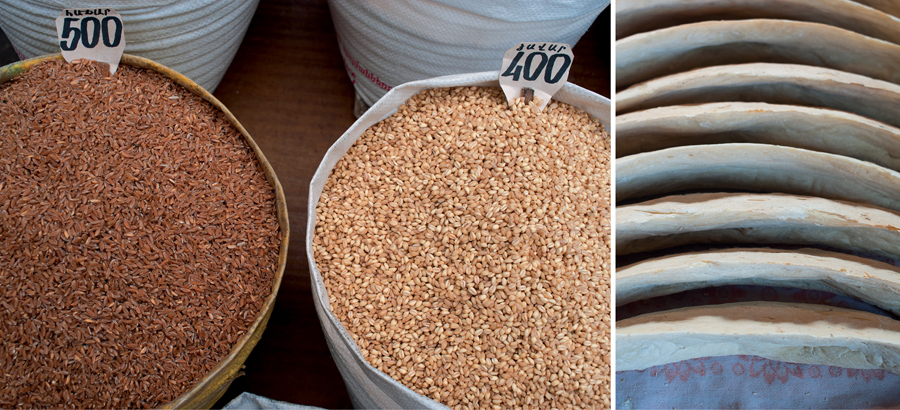
Left: Yerevan, Armenia—The two essential types of wheat in Armenia are hajar, a form of emmer (left), and tsavar, precooked wheat berries (right). The best substitute for tsavar is soft wheat berries (see Armenian Herissah).
Right: Georgia—A batch of Georgian Boomerang Breads (see recipe) in a small rural bakery, lying on their sides to cool.
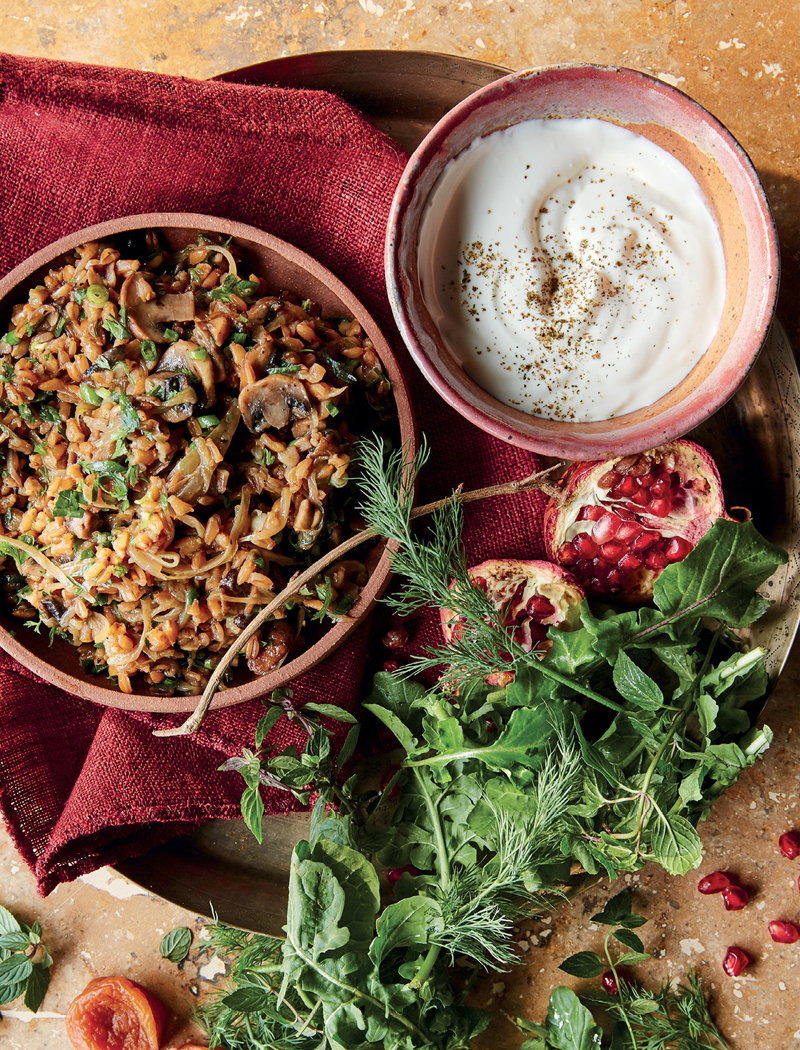
Emmer Mushroom Pilaf, with thick yogurt and an array of fresh herbs.
Emmer is an early variety of wheat that cooks up quickly; it has an inviting homey taste and is a staple in Armenia. Farmers are starting to grow it again in North America. Here it is used in a dish that is a cross between pilaf and risotto.
You can make this with just mushrooms, or you can include a little ground meat. Instructions for both are given below.
Serves 4 to 6
2 tablespoons sunflower or vegetable oil
2 tablespoons butter-ghee or butter (1 tablespoon if using meat)
2 medium onions, thinly sliced (about 1 cup)
½ pound ground pork, beef, or lamb (optional)
½ pound (¼ pound if using meat) mushrooms, chopped: cremini, button, or portobellos (about 4 cups)
2 teaspoons dried thyme
1 cup (scant ½ pound) emmer wheat berries, washed well and drained
2½ cups water or light broth
1½ teaspoons sea salt, or to taste (less if using salted broth)
Generous grinding of black pepper
2 to 3 tablespoons chopped fresh tarragon or mint, or substitute 2 teaspoons Mint Oil (see recipe)
About 2 cups plain thick yogurt (see Glossary), lightly salted
Herb Plate (see recipe)
Place a wide heavy skillet or heavy pot over medium heat. Add the oil and butter; when the butter melts, swirl to coat the pan. Toss in the onions and cook until translucent. Add the meat, if using, the mushrooms, and thyme and cook, stirring occasionally, until the meat has changed color and the mushrooms are starting to soften, about 5 minutes. Add the emmer and water or broth and bring to a boil. Add the salt and bring back to a boil, then lower the heat slightly to maintain a strong boil and cook for 5 minutes.
Cover the pan, lower the heat, and simmer for 30 minutes, or until the emmer is very tender and cooked through. The finished dish should be slightly soupy, like a very thick risotto.
Taste and add salt if needed and the pepper. Stir in the herbs or oil. Serve hot or warm, with yogurt on the side, and the herb plate if you like.
Herissah, often called the national dish of Armenia, is served at Easter and on festive occasions. Cooked wheat berries and chicken or lamb are ground together to a coarse puree. The result is warming and sustaining, like so many of the grain dishes in the repertoire. Herissah is a close cousin of the harissa of Iran (not to be confused with the North African chile paste called harissa).
In Armenia, herissah is traditionally made with tsavar, precooked dried wheat berries (see The Armenian World of Wheat), but those can be hard to find in North America; use soft wheat berries instead (soft wheat cooks a little more quickly than hard wheat) or emmer wheat berries (see recipe).
Start preparing the dish at least 5 hours before you want to serve it. Or cook the wheat berries and meat a day ahead and refrigerate until needed.
You can dress up herissah with loads of chopped fresh herbs, or put out a generous herb plate.
Serves 8
2 cups soft wheat berries or emmer wheat berries, washed well and drained
6 to 7 cups water
1½ pounds boneless lamb shoulder or leg; 2 to 2½ pounds bone-in lamb shoulder, trimmed of excess fat; or 2½ pounds chicken legs and/or breasts
1 onion, quartered
1 teaspoon dried thyme or 2 fresh thyme sprigs
2 bay leaves
About 10 black peppercorns
2½ teaspoons sea salt, or to taste
About ¼ cup dry red wine (or white wine if using chicken) or 2 tablespoons pomegranate molasses (optional)
Freshly ground black pepper
Herb Plate (see recipe)
Lemon wedges
Chopped cucumber and/or chopped tomato
2 cups plain full-fat yogurt, lightly salted
Place the wheat berries in a large heavy pot, add 5 cups water, bring to a strong boil, and boil for 10 minutes. Remove from the heat, cover, and let stand for at least 2 hours, or as long as overnight.
Bring the pot of wheat berries back to a boil and cook at a medium boil until the berries are tender and yielding to the bite, about 1 hour (if using emmer, the cooking time will be a little shorter). Add more water if necessary to prevent burning or sticking. Set aside.
Meanwhile, place the lamb or chicken in another large pot and add water to cover. Add the onion, thyme, bay leaves, and peppercorns and bring to a boil. Partially cover, lower the heat to maintain a gentle boil, and cook until the meat is tender, about 45 minutes (a little longer for bone-in lamb). Lift the lamb or chicken out of the pot and into a large bowl. Strain the stock and set it aside. If using meat on the bone, remove the meat from the bones; discard the bones. (The cooked wheat berries, the meat, and the stock can be refrigerated overnight in separate well-sealed containers.)
When ready to proceed, place some of the wheat berries and meat in a food processor and process to a slightly coarse paste; you may need to add a little of the reserved stock to help with the processing. Working in batches, continue processing until you have ground all the wheat and meat together, then process for a few minutes more to get a reasonably smooth paste.
Transfer the paste to a large heavy pot. Add the remaining stock and the salt, stir, and bring to a low boil over medium heat. I like to add a splash of red wine or pomegranate molasses at this point, though it is not traditional. Cook for another 5 minutes. Add pepper to taste, and adjust the seasoning if necessary.
Serve in individual bowls and put out the accompaniments so guests can help themselves.
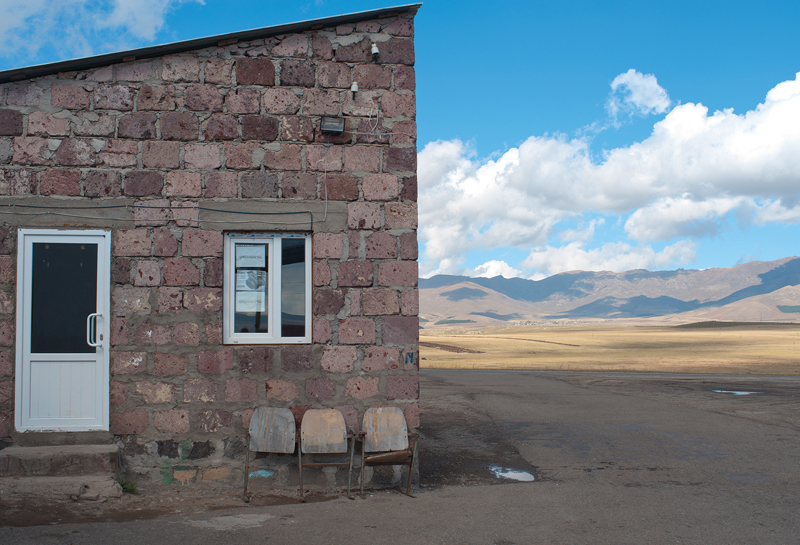
North of Yerevan, Armenia—A rural gas station in high plateau country. The light is bright and harsh here, and the shadows sharp-etched in a way that reminds me of Tibet and Wyoming.
I love ghomi, even though I didn’t grow up with polenta or grits. In the western part of Georgia, particularly in Emereti, as well as in the Georgian-influenced areas across the border in Turkey, corn has been an important staple for centuries. Corn flour is used to make corn flatbreads, and to make this soft cornmeal dish that, at its best, is smooth and silky and completely irresistible.
Ghomi takes about an hour and a half to cook. It’s traditionally made in a heavy cauldron-like pot called a kardala; my heavy Le Creuset pot is ideal. It can be served plain to accompany any meal, but it’s most often served with slices of suluguni, a smoked cheese, set into it. The dish is then called elargi. Instructions for both follow. Serve hot or warm, as a main dish with a vegetable side, or to accompany roasted or grilled meat. Leftovers of ghomi and elargi are delicious sliced and fried in hot oil (see A Note on Leftovers).
Serves 8
2 cups medium-coarse cornmeal, preferably white
7 to 8 cups hot water, or as needed
1 tablespoon sea salt, or to taste
¼ cup fine corn flour, preferably white
About ¼ pound suluguni cheese (see Glossary), or substitute mozzarella or smoked Gouda, sliced into rectangles about 1 inch wide, 2 inches long, and ¼ inch thick
Place the cornmeal in a large bowl and add water to cover generously. Swirl the water and cornmeal with your hand and drain in a fine sieve. Repeat twice.
Place the cornmeal in a heavy pot with 5 cups of the hot water. Bring to a vigorous boil, cover tightly, reduce the heat to the lowest setting, and cook for 15 minutes.
Remove the lid and stir. The mixture will have come together into a smooth porridge. Raise the heat a little and start stirring and smoothing it with a wooden spoon or spatula every couple of minutes. After about 15 minutes, it will have thickened. Add another 2 cups water, lower the heat a little, and stir occasionally to make sure that it’s not sticking.
After another 15 minutes, start stirring fairly constantly to help the starches break down and to smooth out the mixture. If the ghomi gets very thick, so that it’s barely pourable, add another cup or so of water.
Once the cornmeal is tender (after about another 10 minutes), stir in the salt. Sprinkle on the corn flour, stir it in, and cook for another 15 minutes, stirring and smoothing the ghomi fairly constantly; again, add more water if you need to. The texture should be like that of a thick applesauce. Taste for salt and adjust the seasoning if necessary. Pour into a wide shallow bowl.
If you want to make elargi, place the slices of cheese in the ghomi, standing them on their long sides in rows. The hot ghomi will melt them a little.
A Note on Leftovers: Like polenta, ghomi lends itself to a second cooking. Pour leftovers into a rectangular container so they can be easily sliced the next day, cover, and refrigerate. Heat a little sunflower or olive oil in a heavy skillet and fry the slices briefly, turning them once, until lightly browned on both sides and warmed through. Serve with a fried egg on top or with a salad.
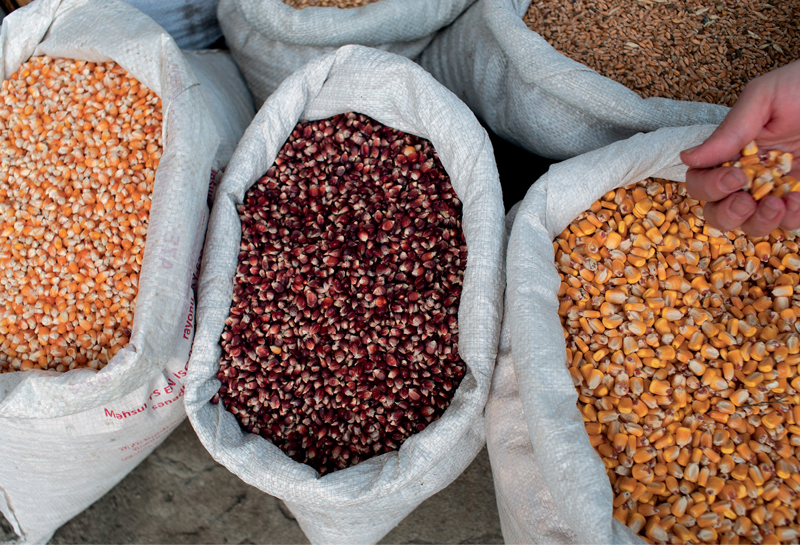
Tbilisi, Georgia—Corn kernels of many colors at the market. Corn originated in the Americas and came to the Caucasus sometime in the last four hundred years. It soon became a valuable crop, especially in western Georgia, displacing millet.